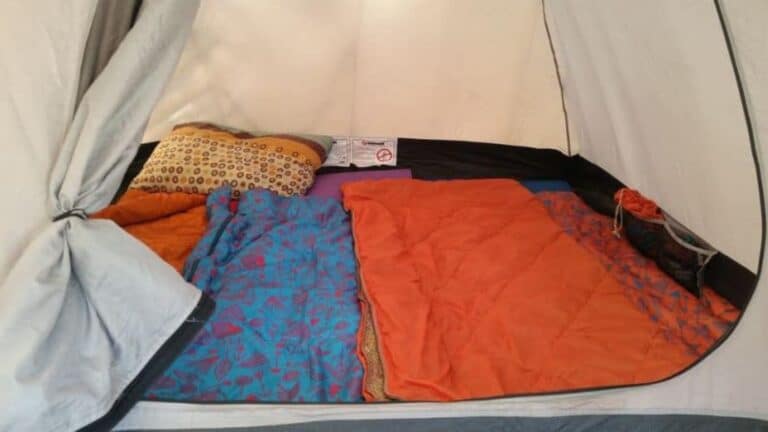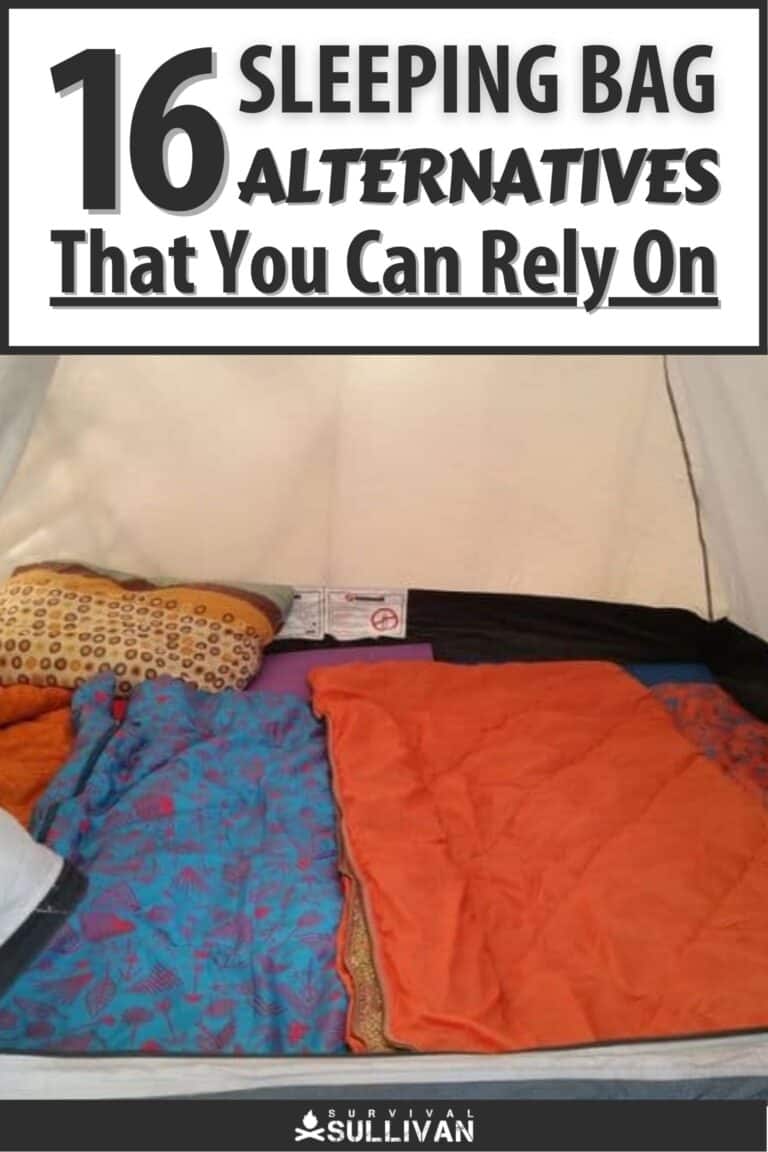We used to do a lot of hiking and camping when I was a kid, and it was always a bit of a struggle when it came to sleeping bags.

We always had them and setting them up was easy enough – just pull it out of the bag and voila you have a bed! Putting them away again… was another story altogether.
Now, these are valuable tools and whether you’re going camping or backpacking or, in an emergency situation, bugging out; you should always have a sleeping bag or at least something similar on hand.
That said, what are some good alternatives that you can use if you don’t have or don’t like sleeping bags?
1. Blankets
Yeah, I know it’s obvious, but I hardly ever saw campers using blankets unless they were in a camper van/mobile home.
Blankets are easy to pack and don’t add a lot of weight to your pack. They also don’t limit your movement like a sleeping bag would.

a few zipper bags
2. Zip Bags
Ziploc. They’re a small brand…you’ve probably heard of them and their resealable sandwich bags?
Okay, all jokes aside; yes, you can use a Ziploc bag as a sleeping bag alternative; one of the largest non-food bags holds 22 gallons, after all.
The problem is that these bags are very thin and not very well insulated, so it won’t be the warmest experience of your camping life.
3. Quilts
Another obvious one, quilts are a bit thicker than your average blanket, so you have some extra protection from the cold and, if folded correctly, they won’t take up too much space in your pack.
You can get quilts that are more akin sleeping bags if you prefer them, but a regular, blanket-style quilt will do just fine.
4. Bivouac/Bivy Bag
A bivy bag is a type of shelter that’s a sort of hybrid between a tent and a sleeping bag.
It’s usually a waterproof/water-resistant fabric shell that’s designed to be slipped over your sleeping bag – with a rigid framework keeping it stable and giving you space to breathe.
They’re lightweight and very usable but they aren’t very well-insulated and tend to accumulate moisture on the inside so that’s something to consider.
5. Liners
You know that interior layer of your sleeping bag? It’s usually got Velcro or something along the sides of it to allow for easy removal (i.e. for cleaning).
That interior layer/liner is there to provide additional insulation, but you can also use it as a sleeping bag on its own.
This is a good option if you want the warmth of a sleeping bag without the added bulk of the outer shell.
6. Your Car
Is this cheating? Probably, but it still counts! Your car has a solid structure and will keep the cold wind and the rain off you.
It’s not the most comfortable way to camp (trust me, I know) but if, for example, the rain comes down and floods your tent; then yeah, it’s a good option.
7. Warm Clothes
This is probably not my favorite alternative, but it is an option. If you don’t have a sleeping bag on hand, then dressing up in layers of warm clothing will help to keep you warm – provided, of course, that you don’t get caught in a storm.
8. Hammocks and Insulated Hammocks
So, let’s get the obvious out of the way; one of the benefits you’ll get out of a hammock is that you’re off the ground.
Cheap and relatively easy to make, hammocks don’t take up a lot of space – unless they’re insulated – and are nice and light.
Insulated hammocks are hammocks with a layer of insulating material built into them.
They’re notably more expensive and tend to take up more space than a regular hammock. Either option is good, it depends on you and your needs.
9. Tarpaulin
Lightweight and easy to use, tarps are readily available in most retailers and don’t take up a lot of space.
There is, however, a caveat to all the convenience; it’s not insulated which means that unless you’ve got blankets or a sleeping bag you’re in for a very uncomfortable night.
10. Air Mattresses
This was a common method that we used, although, we used them together with sleeping bags.
Air mattresses are very comfortable and they’re not horribly expensive. You just inflate it, spread a blanket over it and you’ve got a bed.
The biggest problem would be that these can take up quite a bit of real estate in your pack.
You’d also best make sure that you’ve got a manual pump on hand because otherwise your lungs are going to get quite a workout!
11. Camp Mat and Sleeping Bag/Blanket
A camping mat is exactly what it sounds like, a mat on which you sleep – surprise, surprise.
They’re usually made of foam and are both lightweight and comfortable. The only problem I have with them is that they can take up space.
You can use them in conjunction with both sleeping bags and blankets and they’re easy to maintain.
12. Folding Camp Cot/Stretcher
Folding camp cots or stretchers aren’t the most comfortable but, after a long day’s hiking, you won’t really be bothered by that. They’re easy enough to set up, but they also tend to be heavy and bulky.
With that in mind, if you’re doing a long-distance hike and you want to travel light then this probably isn’t the best option.
13. Backcountry Bed
This is essentially designed to be a roomier sleeping bag that you can adjust to your needs. It has a larger interior and an integrated quilt. The only downside is that these can be heavy so they’re not ideal for long-haul trips.
14. Sand
This is more of a survival situation measure for if you’re stranded somewhere and need to sleep somewhere warm.
You literally bury yourself – partially – in the ground. The warm sand keeps you warm. Unfortunately, this method carries significant risk.
Apart from possibly disturbing unfriendly wildlife, the sand is very restrictive, and if it rains you may have to bail in a hurry – which isn’t easy when the sand has compacted around you.
15. Grass in a Dugout
Obviously, this method assumes that you’ve got plenty of long grass around and it’s a bit more involved than some of the other methods on this list.
For starters, you dig a ditch of comfortable size and line the bottom with a layer of grass.
To make it warm, you heat rocks in a fire and place them under the grass (obviously they can’t be too hot), you then cover yourself with long grass.
It’s not the most comfortable and it isn’t very well insulated but, much like the sand, this is more of a survival thing than a luxury thing.
16. Space Blanket
Also called an emergency blanket or first aid blanket, these are made of a thin, heat-reflective material that prevents the loss of body heat. These are often found in emergency kits to help prevent hypothermia.
They’re lightweight and take up virtually no space in your pack and, as such, are popular with the outdoorsy crowd.
In Closing: Plenty of Options
This is just a small handful of alternatives that you could use; there are so many ways to make your campsite comfortable – with or without a sleeping bag.
I hope you guys and gals enjoyed the article and found it informative. As always, thanks for reading, I’ll see you soon.
Take care and Happy Camping!

The post 16 Sleeping Bag Alternatives You Can Rely On appeared first on Survival Sullivan.
By: Greg Seebregts
Title: 16 Sleeping Bag Alternatives You Can Rely On
Sourced From: www.survivalsullivan.com/sleeping-bag-alternatives/
Published Date: Sun, 29 Jan 2023 17:00:00 +0000
------------------------
Did you miss our previous article...
https://bushcrafttips.com/bushcraft-news/a-new-path-a-custom-f250-built-for-a-tripleamputee-eod-veteran
 What is BushcraftSurvival SkillsToolsVideosBushcraft CampsBushcraft KitsBushcraft ProjectsPrivacy PolicyTerms And Conditions
What is BushcraftSurvival SkillsToolsVideosBushcraft CampsBushcraft KitsBushcraft ProjectsPrivacy PolicyTerms And Conditions
